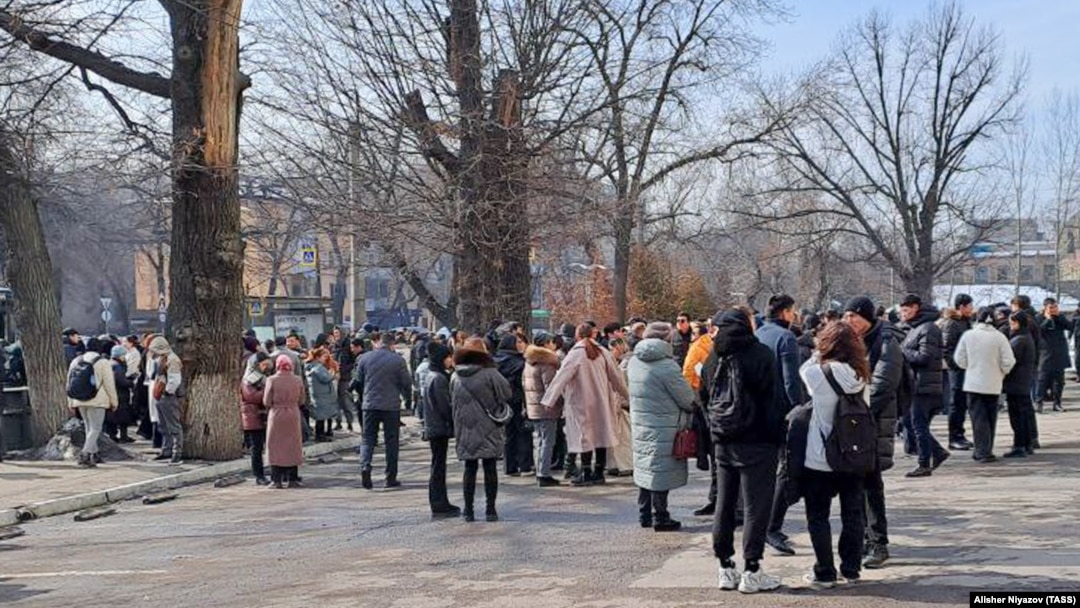ALMATY -- Many of the some 2 million residents of Kazakhstan's largest city are getting used to describing earthquakes.
If the one that struck Almaty in January was the long, rumbling sort with a prominent aftershock, then the one that hit on March 4 was shorter but more violent, feeling somehow like an even greater test of what the city is made of.
"You need to understand that the epicenter of the last seismic event in January was 300 kilometers from Almaty," explained Rustambek Amrin, an official from the Emergencies Ministry, at a briefing on March 4. "That is, it took the tremor 10-20 seconds to reach Almaty. Today's event was 30 kilometers from Almaty."
Amrin was explaining to journalists why sirens designed to work during a "seismic event" only came on minutes after the quake that sent city dwellers scurrying out of their apartments and quickly saw the city's roads gridlocked with cars.
But it was the official's point about distances that seemed most pertinent in the aftermath of the 5.0-magnitude quake.
From January to March. From 300 kilometers to 30.
Almaty's earthquakes are not just getting more frequent. They are striking closer to home.
Suitcase. Train Station. Astana.
At least this one struck at a decent hour -- 11 in the morning.
The January 23 quake that had its epicenter in a remote stretch of neighboring China's northwest region of Xinjiang hit right after midnight, when many in the city were asleep.
Given that Almaty had not experienced anything similar in a long while, the effect was chaotic. While nobody died, dozens sought treatment for injuries, including several who leapt from second- and third-floor apartment windows.
Gas stations ran low on supplies as drivers crushed into lines to stock up before driving somewhere, anywhere, to escape their homes and avoid the cold.

People gather in the street after the earthquake in Almaty on January 22.
This week, as in January, Kazakh social media filled up with jokes about how attractive the chilly, sterile, but seismically safe Astana suddenly looked in comparison to the leafy, mountain-crowded city that it replaced as the country's capital.
"Suitcase. Train station. Astana," was a common refrain, and one that many followed through on.
Plane tickets for major carriers flying between Almaty and Astana on March 4 quickly dried up, media reported, as images of cracked walls and other moderate damage proliferated online.
Children were sent home from schools -- many of which double up as gathering points -- although kindergartens mostly continued working.
"We were in a taxi," recalled one elderly woman of the moment the quake struck in an interview with RFE/RL's Kazakh Service.
"I asked the driver, 'Young man, is there a problem with your gasoline or are we getting shot at?' He said: 'Lady, it's an earthquake. But what can you do? We are at the mercy of fate.'"
The Sound Of Sirens
Kazakhstan's Emergencies Ministry said last week that 14 of its employees were disciplined in connection with the failed response to the January 23 earthquake. On that occasion, the city's siren system failed to function, leading some angry residents to fire off accusations of budget-stealing.
Nurlan Atygaev, Almaty's top emergencies official, said at the time that the authorities had not wanted to "sow panic" by turning on the sirens, which he said were typical for "strong earthquakes" of 5.5 magnitude and above.
This time the system was switched on, notwithstanding the fact that the earthquake was less than 5.5 magnitude, with loudspeakers warning citizens to turn off water, electricity, and gas, gather necessary documents, and leave their homes -- albeit after many already had.
Atygaev's colleague Amrin explained that the proximity of the epicenter made it impossible for the sirens to sound any earlier. He also said the ministry plans to replace its SMS earthquake notifications, some of which arrived more than half an hour after the fact or not at all, with "momentary" push notifications in the near future.
The ministry has since forecasted a "70 percent likelihood" that a strong earthquake would not follow in the coming days.
Nagging doubts about Almaty's earthquake preparedness grew louder in the wake of the devastating quake that hit parts of Turkey and Syria in February 2023, killing more than 50,000 people and leaving twice as many injured.
Then the talk dissipated.
But a year down the line, Almaty has experienced two nerve-rattling quakes in quick succession, although none as strong as the pair that in 1887 and 1911 destroyed large parts of its previous incarnation -- a modest, imperial Russian fort town called Verny.
Nowadays, Almaty is Kazakhstan's sprawling financial center and construction has fanned out in all directions, including into the mountains where tremors are especially keenly felt.
Almaty in July 2022
Like this latest quake, the deadly convulsion that struck Verny in 1911 had an epicenter close to modern-day Kazakhstan's border with Kyrgyzstan, a fact that led independent, Almaty-based seismologist Mukhtar Khaidar to talk of an "awakening" of the Chilik-Chon Kemin Fault. (The Kyrgyz capital, Bishkek, felt strong tremors on January 23 but not on March 4.)
"There is nothing good in this," Khaidarov warned in comments widely cited by Kazakh media.
But Daulet Sarsenbaev, director of the government-backed National Center for Seismological Observations and Research, played down the suggestion, arguing that the epicenter's coordinates indicated it was a "separate seismic event," pointing out that quakes in 2015 and 1990 could be traced to a similar area.
"As to [the idea] that it is an awakening of the Kemin fault, where the [1911] Kemin earthquake occurred -- this is just the assumption of one person with nothing behind it," he said.


